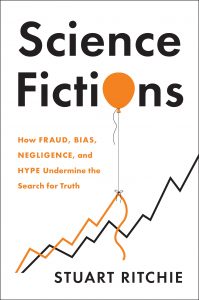
We’re pleased to present an excerpt from Stuart Ritchie’s new book, Science Fictions: How Fraud, Bias, Negligence, and Hype Undermine the Search for Truth.
One of the best-known, and most absurd, scientific fraud cases of the twentieth century also concerned transplants – in this case, skin grafts. While working at the prestigious Sloan-Kettering Cancer Institute in New York City in 1974, the dermatologist William Summerlin presaged Paolo Macchiarini—an Italian surgeon who in 2008 published a (fraudulent) blockbuster paper in the top medical journal the Lancet on his successful transplant of a trachea—by claiming to have solved the transplant-rejection problem that Macchiarini encountered. Using a disarmingly straightforward new technique in which the donor skin was incubated and marinated in special nutrients prior to the operation, Summerlin had apparently
grafted a section of the skin of a black mouse onto a white one, with no immune rejection. Except he hadn’t. On the way to show the head of his lab his exciting new findings, he’d coloured in a patch of the white mouse’s fur with a black felt-tip pen, a deception later revealed by a lab technician who, smelling a rat (or perhaps, in this case, a mouse), proceeded to use alcohol to rub off the ink. There never were any successful grafts on the mice, and Summerlin was quickly fired.
Summerlin is hardly alone among scientists in indulging an illicit artistic urge. It’s commonly seen in the figures that illustrate scientific papers. With computer graphics, it’s never been easier to crop, duplicate, touch up, splice, recolour, or otherwise alter scientific images to make them show whatever you want. Of course, producing fraudulent photographs was eminently possible well before the Photoshop era (just ask Commissar Nikolai Yezhov, who was famously ‘disappeared’ from a photo with Joseph Stalin after he fell out of favour with the Soviet leader). In 1961, Science magazine apologised for publishing an article by Indian veterinary researchers who claimed to have found the parasite toxoplasma gondii for the first time in chicken eggs (a potential health risk since the parasite can cause toxoplasmosis, a dangerous disease for those with weakened immune systems). The evidence of the presence of the parasite – microscope photos of its cysts in an egg – was, it turned out, fake. What the researchers claimed were two different cysts were in fact the same photo that had been zoomed out and flipped horizontally, a duplication that’s crashingly obvious in retrospect, but that the peer reviewers missed. After the foul play was discovered, the researchers were soon forced to retire, or suspended from their positions.

You might think that only the laziest scientific frauds would use duplicated images in their papers, making their deceit visible to the vigilant naked eye. But image duplication comes up again and again, and has been a central feature of some of the most prominent fraud cases of recent decades. In 2004, the South Korean biologist Woo-Suk Hwang announced in a Science paper that he’d successfully cloned human embryos. The next year, in the same journal, he reported that he’d produced, from those embryos, the first cloned human stem cell lines. What gives stem cells their potential, beyond the fact that they can keep multiplying indefinitely, is that they’re ‘pluripotent’, meaning they can be transformed in the lab, Swiss-Army-knife-like, into many different types of tissues (neurons, liver cells, blood cells, and so on). Cloned cell lines – eleven of them had been produced for Hwang’s paper – might have allowed the production of personalised stem cell treatments, and thus the repair of damaged tissues and the regeneration of injured or diseased organs. As with the trachea transplants, this would mean that the personalised stem cells came from that same individual, and that their immune system would be less likely to reject any treatments that used them. In yet another breakthrough that same year, Hwang’s team at Seoul National University introduced the world to the first ever cloned dog, an Afghan hound named Snuppy.
It’s hard to overstate how famous these achievements made Hwang in South Korea. He was venerated in the media. Posters of his face, with statements like ‘Hope of the World – Dream of Korea’, appeared in the streets and on public transport. The Korean post office issued a special postage stamp in 2005 celebrating his work, showing (perhaps rather prematurely) a series of silhouettes of a person standing up from their wheelchair, leaping into the air, and hugging a loved one. The Korean government, who named Hwang ‘the Supreme Scientist’, poured enormous sums into his research. Hundreds of women reached out to Hwang to donate their eggs for his studies.
You can guess what happened next. Further inspection of the paper in Science revealed that two of the images, purportedly showing Hwang’s cell lines for different patients, were identical (and just to be clear, there was effectively zero chance of two images of this sort being identical by mere coincidence). There was also overlap in two more, which came from parts of the same photo but had been passed off as entirely different. If these were the only problems, it could easily have been an oversight – someone might have mixed up or mislabelled the photos. Far from it. Whistleblowers from Hwang’s lab revealed that only two cell lines had been created, not eleven, and nei- ther were from cloned embryos. The rest of the cell photos had been doctored or deliberately mislabelled under Hwang’s instructions. The entire
research project had been a charade.
Even before the concerns about image manipulation were raised, Hwang had been in hot water for obtaining eggs from donors who were neither fully informed of how their eggs would be used, nor of the potential dangers of having them extracted. Hwang had also pressured the female members of his lab to donate their own eggs for experimentation. The revelations of misconduct kept coming: Hwang had siphoned off some of his research funding into a network of bank accounts that he controlled – and although he claimed the money was still spent on scientific apparatus, an investigation revealed that the ‘apparatus’ included a new car for his wife and donations to supportive politicians.
The glowing media coverage of Hwang had been so intense that not even this egregious scientific fraud was enough to put off his admirers. Protestors lined the streets outside the offices of media organisations who ran negative stories and filled up their online forums with thousands of irate pro-Hwang posts. Nevertheless,
the authorities had to react. Hwang was fired from his university, then criminally prosecuted, although he managed to avoid jail with a two-year suspended sentence. These days he’s still working on cloning, but at a less prestigious university, and his work receives a tiny fraction of the attention it once captured. Incidentally, amongst all Hwang’s counterfeit accomplishments, Snuppy was real: DNA tests revealed he was a genuine clone of another Afghan hound named Tai. Snuppy died in 2015, but he’s still around, in a sense: four further clones of him were born two years later.
Hwang was easily the most famous scientist in his country, and one of the world’s most prominent biologists. Given all the attention he received in that position, why did he think he could get away with such blatant, careless fraud? The answer speaks not just to his own (lack of) character, but to something broken about the scientific system. As we noted above, the system is largely built on trust: everyone basically assumes ethical behaviour on the part of everyone else. Unfortunately, that’s exactly the sort of environment where fraud can thrive – where fakers, like parasites, can free-ride off the collective goodwill of the community. The fact that Hwang’s acts were so shameless only showcases how gullible reviewers and editors – the very
people we rely upon to be rigorously sceptical – can be when faced with such exciting, ‘ground-breaking’ results.
Stuart Ritchie is is a faculty member at the Social, Genetic and Developmental Psychiatry Centre at King’s College London.
Like Retraction Watch? You can make a tax-deductible contribution to support our work, follow us on Twitter, like us on Facebook, add us to your RSS reader, or subscribe to our daily digest. If you find a retraction that’s not in our database, you can let us know here. For comments or feedback, email us at [email protected].